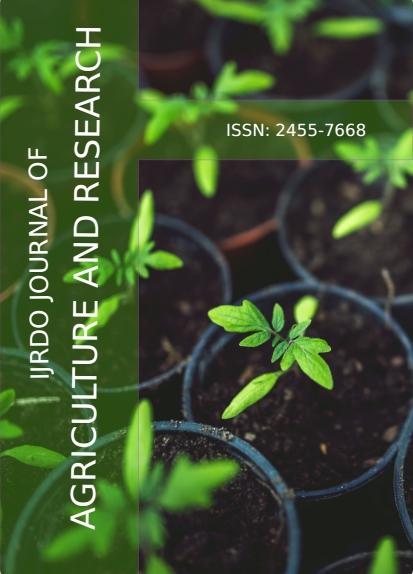Transfer of 20,000 hectares of farmland to Fanaye: investment or grabbing and spoliations?
Abstract
For a decade or more, Senegalese government action has been reflected in the gradual deployment of a policy of action oriented towards the intensification of agricultural products and the valorization of private entrepreneurship. It is in this context that the group consisting of Senhuile SA and Senethanol SA in agreement with the authorities of the country, in 2011, was trying to carry out a project of production of sunflower seeds and bioethanol on an area of 20 thousand hectares in the rural community of Fanaye (department of Podor, Saint-Louis region, at the level of the Senegal River Valley). Faced with this process of monopolization, the people of Fanaye, victims of the wickedness and sadism of these private companies to the great silence of the authorities, tried to resist against this fact accomplished. To curb, therefore, this allocation of peasant lands to private investors, several actions are carried out. Farmers use a repertoire of activities ranging from national and international press campaigns, to the filing of memoranda,
to the organization of violent demonstrations and legal recourse.
For example, peasants, shepherds, farmers, the unemployed, former illegal migrants, fishermen, herders whose survival is threatened (local grassroots groups and village women and youth committees) and Senegalese civil society organizations mobilized to stop these ruthless land grabbing of Fanaye lands, inherited from generation to generation. The stubbornness of the president of the rural council and the officials of the Senhuile SA and Senethanol SA company, as well as the deafening silence of the administrative authorities, despite the unceasing appeals of the population, led to violence resulting in loss of life and injuried people. This article describes and analyzes how the cession of 20,000 hectares of land to Italian investors, without any real consultation with the population, provoked an explosion of anger in the rural community of Fanaye, in the Senegal River Valley. The article aims to make the problem of land grabbing in Fanaye understood through abusive and illegal deliberations, to raise the impertinence, the opacity surrounding the Sénéthanol project, the economic and environmental risks, and the questionable approach of its leaders, as well as the various actions of the Collective in order to assert the right of the populations and to make peace reign.
Downloads
References
APS. «Les populations de Wassadou protestent contre l'accaparement de leurs terres.» Agence
de presse Senegalaise, 2012.
Benkhala, Faye, Touré, Seck, et Ba. Les organisations paysannes dans le processus de réforme
foncière. Dakar: Ipar, 2010.
Brondeau, Florence. «Les investisseurs étrangers à l'assaut des terres agricoles africaines.»
EchoGéo, 2010.
Châtelot, Christophe. «Au Sénégal, Abdoulaye Wade reconnaît sa défaite.» Le Monde, 2012.
Chouquet, Gerard. «Comprendre les acquisitions massives de terres dans le monde
aujourd'hui.»Knowing to manage the territory, protect the environment, evaluate the cultural
heritage. 2012.
Cissé, Ndiogou. «La Cour d'Appel Annule la Liberté provisoire des prévenus.» Le Pays, 2012.
Cissé, Yacine. «Scandale Foncier à Podor: des italiens font main basse sur 20.000 ha de terres.»
Wal Fadjri, 2011.
Cochet, Hubert. «Terre-Ethique.» articles hubert Cochet achats et locations de terres sur la
planete état des lieux. Novembre 2012. http://terrethique.org/articles/hubert-cochet-achats-etlocations-de- terres-sur-la-planete-etat-des-lieux/ (accès le Janvier 2013).
Cotula, Lorenzo, Sonja Vermeulen, Rebeca Leonard, et James Keeley. Land grab or
developement opportunity? Agricultural investment and international land deals in Africa.
FAO, IIED, FIDA, 2009.
Coulibaly, Adama. «Projet Sen Huile Sen Ethnaol: deux blessés dans un affrontement entre
forces de l'ordre et les populations.» Sunuker, 2013.
EndaPronat. L'accaparement de Terres au Sénégal, la lutte d'Enda pronat et de ses partenaires
paysans. Dakar: Endapronat, 2012.
FIDH. Terrains défrichés, Droits piétinés, les Impacts des plantations industrielles d'Hévea de
Socfin- KCD sur les communautés autochtones de Boursa, Mondul Kiri. FIDH, 2011.
HLPE. «Régimes Fonciers et Investissements Internationaux en Agriculture, Rapport du
Conseil de Sécurité Alimentaire.» Rome, 2011.
ILC. Investissements et régulation des transactions foncières de grande envergure en Afrique
de l'Ouest. International Land Coalition, 2011.
IPAR. Impact des investissements agricoles italiens dans le biocarburant au Sénégal: Etude de
cas dans les zones de Fanaye (st louis), Nétéboulou et de Ndogo Babacar (Tambacounda).
Dakar: Ipar Action Aid Italie, 2012.
Kane, Abou. «Fanaye: Wade arrête définitivement le projet".» Wal Fajri, 2011.
Sène, Lamine. «Suspension du Projet après les violences du projet agricole de Fanaye.» Nettali,
2011.
Mayol, Philippe. Analyse sur les émeutes contre la faim en Afrique Sub-saharienne. CCFD,
2008.

This work is licensed under a Creative Commons Attribution-NonCommercial-NoDerivatives 4.0 International License.
Author(s) and co-author(s) jointly and severally represent and warrant that the Article is original with the author(s) and does not infringe any copyright or violate any other right of any third parties, and that the Article has not been published elsewhere. Author(s) agree to the terms that the IJRDO Journal will have the full right to remove the published article on any misconduct found in the published article.



